The toaster market is estimated to be valued at USD 5.2 billion in 2025 and is projected to reach USD 7.9 billion by 2035, registering a compound annual growth rate (CAGR) of 4.3% over the forecast period. A compound absolute growth analysis reveals steady expansion throughout the forecast period, driven by steady demand in both developed and emerging markets. Between 2025 and 2030, the market grows from USD 5.2 billion to USD 6.4 billion, contributing USD 1.2 billion in growth, with a CAGR of 4.5%. This early-phase growth is driven by rising demand for advanced toasters that offer convenience features such as smart controls, energy efficiency, and additional functionalities like rapid toasting and multi-functionality.
The growth is further supported by consumer preferences for high-quality, durable kitchen appliances, as well as a growing trend in home cooking and food preparation. From 2030 to 2035, the market continues to expand from USD 6.4 billion to USD 7.9 billion, contributing USD 1.5 billion in growth, with a slightly lower CAGR of 4.0%. This deceleration indicates that the market is approaching maturity, particularly in developed regions where most households already own toasters. However, growth remains steady in emerging markets where increasing disposable incomes, urbanization, and changing lifestyles continue to drive demand for modern, convenient kitchen appliances. The compound absolute growth analysis reflects consistent demand, supported by innovation and emerging consumer trends.

| Metric | Value |
|---|---|
| Toaster Market Estimated Value in (2025 E) | USD 5.2 billion |
| Toaster Market Forecast Value in (2035 F) | USD 7.9 billion |
| Forecast CAGR (2025 to 2035) | 4.3% |
The toaster market is experiencing consistent growth as consumers seek efficient, compact, and user-friendly appliances that align with fast-paced lifestyles. Rising demand for quick breakfast solutions and energy-efficient kitchen tools has supported the expansion of toaster usage in both urban and semi-urban households.
Technological innovations such as multi-slice functions, variable browning control, and smart temperature regulation have added value to the product offering. The growing influence of home cooking trends and premium kitchen aesthetics is further stimulating demand.
Brands are also focusing on improved safety features and user experience to attract health-conscious and convenience-driven consumers. With evolving consumer preferences and rising disposable income levels, the market is poised for steady expansion across both budget and high-end segments.
The toaster market is segmented by product type, price range, application, distribution channel, and geographic regions. By product type, the toaster market is divided into Pop-up, Conveyor, Oven, and Others (toaster grills, etc.). In terms of price range, the toaster market is classified into High, Medium, and Low.
Based on the application, the toaster market is segmented into Household and Commercial. By distribution channel, the toaster market is segmented into Online and Offline. Regionally, the toaster industry is classified into North America, Latin America, Western Europe, Eastern Europe, Balkan & Baltic Countries, Russia & Belarus, Central Asia, East Asia, South Asia & Pacific, and the Middle East & Africa.

The pop-up segment is projected to hold 58.30% of the total market share by 2025 under the product type category, establishing it as the dominant segment. This is due to its compact design, ease of use, and widespread availability across retail formats.
Pop-up toasters are favored for their simple operation and quick heating capabilities, making them ideal for daily household use. Their affordability and low maintenance requirements also contribute to their popularity, especially among first-time buyers and small households.
Continuous enhancements in design, such as wider slots and multi-setting controls, have reinforced their utility and appeal. As consumers prioritize practical and space-saving appliances, the pop-up toaster remains the preferred choice in the product type category.
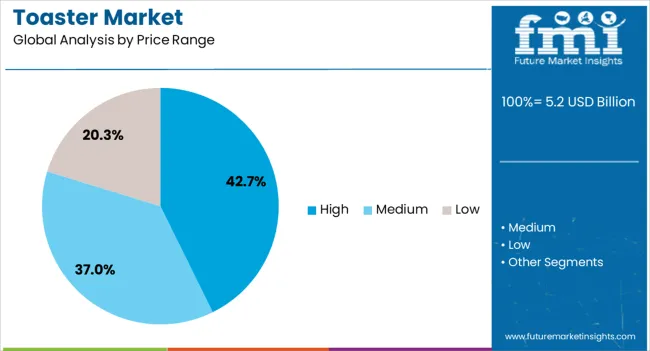
The high price range segment is expected to capture 42.70% of the total market share by 2025 within the price range category, making it the leading segment. This growth is supported by consumer preference for premium appliances with advanced features, sleek aesthetics, and long-term durability.
High end toasters often include digital controls, smart timers, defrost and reheat functions, and enhanced safety systems. Demand is particularly strong among urban consumers who value kitchen aesthetics and multifunctionality.
Additionally, increased brand focus on offering customizable and energy-efficient models in the premium range has attracted a quality-conscious demographic. This segment’s expansion reflects a broader shift toward lifestyle-oriented purchasing behavior in the kitchen appliance market.
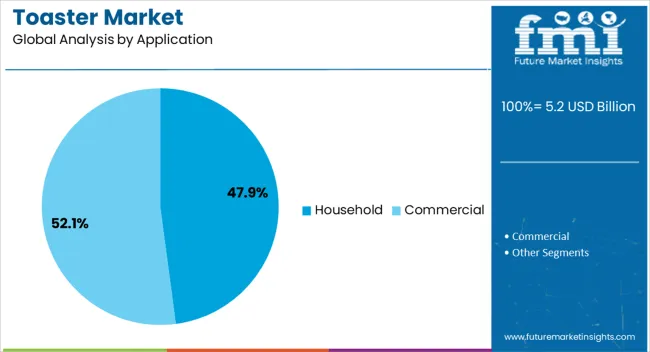
The household segment is anticipated to contribute 47.90% of the total revenue share by 2025 within the application category, marking it as the largest segment. This leadership is driven by the rising number of nuclear families, growing penetration of small appliances in domestic kitchens, and the everyday utility of toasters in home settings.
Convenience, time efficiency, and ease of cleaning have made toasters a staple in household kitchens. The availability of multiple designs catering to various kitchen layouts and user preferences has further accelerated adoption.
Moreover, increasing awareness of energy conservation and healthy eating habits has prompted households to adopt toasters with smart features and safety certifications. As a result, the household segment continues to dominate the market due to its consistent demand and broad consumer base.
The toaster market is expanding due to the increasing demand for convenient and efficient kitchen appliances. Toasters, especially those with advanced features such as multiple settings, wide slots, and smart functionalities, are becoming a staple in households. The growing trend of breakfast-oriented meals and time-saving devices, combined with innovations in design and energy efficiency, is fueling market growth. Despite challenges such as market saturation and the competition from multifunctional kitchen appliances, the market continues to thrive due to consumer preference for quick and easy meal preparation.
The growth of the toaster market is primarily driven by the increasing demand for convenience in meal preparation, especially in the fast-paced lifestyles of today’s consumers. Toasters offer quick and easy ways to prepare breakfast or snacks, making them a popular choice in households worldwide. Consumers are seeking appliances that save time, especially with busy morning routines. The rise in the popularity of breakfast-centric meals, such as toasted bread, bagels, and pastries, is driving demand for advanced toasters that offer more versatility. Manufacturers are also offering toasters with new features such as digital controls, smart functions, and energy-efficient designs to meet consumer needs. The shift towards health-conscious eating is prompting the adoption of toasters that can accommodate healthier bread options, like whole grain and gluten-free varieties, further boosting market demand.
One of the major challenges facing the toaster market is market saturation, particularly in developed economies where the demand for basic toasters has already been met. With a high number of similar products available in the market, differentiation has become difficult for manufacturers. To stand out, companies must offer unique features, such as multi-functional or smart toasters, to attract consumers. Additionally, price sensitivity is another challenge, particularly in emerging markets where consumers are more cost-conscious. In these regions, the demand for high-end, feature-rich toasters is limited, and manufacturers need to balance cost and quality to remain competitive. Offering affordable yet high-quality options will be key to sustaining market growth in price-sensitive regions.
The toaster market offers significant growth opportunities through innovations in design and the integration of smart technologies. Consumers are increasingly looking for appliances that provide more than just basic functions, with a growing interest in toasters that offer customizable settings, such as variable browning controls, defrosting functions, and bagel settings. The rise of smart home appliances presents an opportunity for manufacturers to develop toasters with Wi-Fi connectivity and app integration, allowing users to control their toaster remotely via smartphones. Another opportunity lies in designing more compact, space-saving toasters that fit the needs of modern kitchens. Manufacturers who can offer products with advanced features, sleek designs, and enhanced energy efficiency will be able to capture a broader customer base, particularly in urban areas where convenience and innovation are key drivers.
A key trend in the toaster market is the increasing demand for multi-functional appliances that offer a variety of cooking options. Consumers are seeking products that provide more than just basic toasting functions, such as those that also grill, bake, or even air fry. The trend towards all-in-one kitchen appliances is shaping the toaster market, with manufacturers integrating additional cooking functions into their models. Another significant trend is the growing integration of smart technology, with many modern toasters featuring digital controls, LED displays, and the ability to connect to smartphones or smart home systems for remote control and automation. The increasing consumer preference for convenience and customization in kitchen appliances is driving this trend. The use of eco-friendly materials in toaster production is also gaining popularity, as consumers increasingly look for environmentally conscious options.
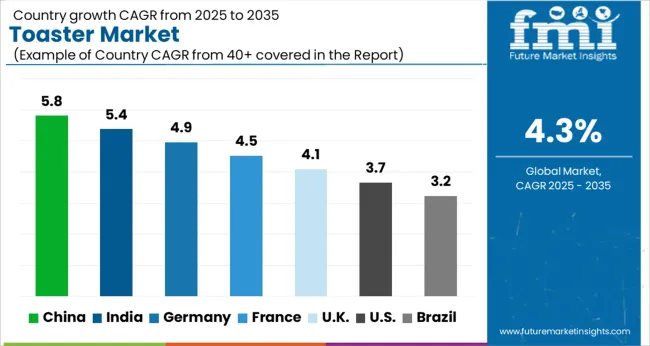
The global toaster market is projected to grow at a global CAGR of 4.3% from 2025 to 2035. China leads the market with a growth rate of 5.8%, followed by India at 5.4%. Germany records a growth rate of 4.9%, while the UK shows 4.1% and the USA follows at 3.7%. The market is primarily driven by increasing demand for kitchen appliances, changing consumer preferences for advanced toasters with innovative features, and growing disposable incomes. China and India are leading the growth, driven by urbanization, rising living standards, and increasing penetration of modern kitchen appliances. Developed markets like Germany, the UK, and the USA are witnessing steady growth, fueled by ongoing product innovations and increasing demand for time-saving, energy-efficient appliances. The analysis spans over 40+ countries, with the leading markets shown below
The toaster market in China is growing at a 5.8% CAGR, supported by rapid urbanization, increasing disposable incomes, and the growing adoption of modern kitchen appliances. With a large population and rising living standards, there is a growing demand for convenient and energy-efficient household products like toasters. As consumer preferences shift towards advanced toasters with multifunctional features such as temperature control, browning settings, and automatic shut-off, the market is expanding. with the growing trend of Western-style breakfasts in urban areas, the demand for toasters is further accelerating. China’s robust manufacturing capabilities also contribute to the affordability and accessibility of toaster products.
The toaster market in India is expected to grow at a 5.4% CAGR, driven by increasing demand for modern kitchen appliances in urban and semi-urban areas. As more consumers embrace convenience and time-saving appliances, toasters are becoming a common household item in India. The rise in disposable incomes, along with changing consumer lifestyles and eating habits, is pushing the demand for advanced and energy-efficient toasters. As urbanization increases and the demand for Western-style cooking grows, the adoption of toasters is expected to rise. The availability of affordable toasters with innovative features further drives market growth in India.

The toaster market in Germany is projected to grow at a 4.9% CAGR, driven by consumer demand for high-quality and energy-efficient kitchen appliances. As one of the leading European markets for household appliances, Germany sees a strong preference for reliable and durable toasters with advanced features. The growing trend towards healthier eating, combined with rising interest in multi-functional kitchen appliances, is further boosting demand for innovative toasters. As Germany embraces energy-efficient technologies in home appliances, consumers are increasingly choosing toasters with energy-saving features. The market is also benefiting from the growing demand for compact, stylish designs that complement modern kitchens.
The UK toaster market is expected to grow at a 4.1% CAGR, driven by the increasing demand for time-saving and convenient kitchen appliances. With a strong focus on product innovation, toasters with advanced features like multiple browning levels, wider slots, and energy-efficient functions are gaining popularity. The UK market also benefits from rising consumer interest in healthy eating habits, which drives the demand for toasters that offer customizable settings for optimal results. As the trend toward smaller, compact kitchen appliances grows, there is an increased preference for toasters that save space while offering high performance.
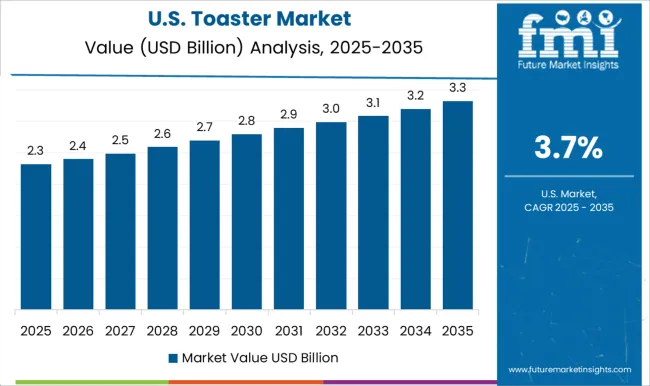
The USA toaster market is projected to grow at a 3.7% CAGR, supported by continued demand for kitchen appliances that offer convenience, performance, and energy efficiency. As the USA market becomes increasingly focused on healthy eating habits, consumers are seeking toasters that can provide customizable settings for different bread types and desired textures. The rise of compact and multifunctional kitchen gadgets is contributing to the adoption of smaller, more versatile toasters that can fit into modern kitchens. In addition, the demand for energy-efficient products in the USA is encouraging the adoption of toasters with improved energy-saving features.
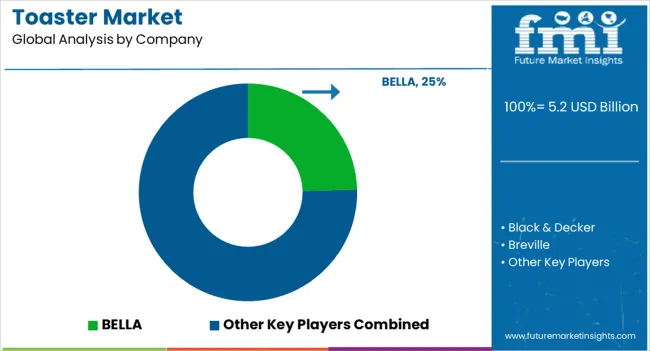
The toaster market is highly competitive, with several leading brands offering innovative, reliable, and efficient appliances to cater to a wide variety of consumer needs. BELLA is known for offering affordable, high-quality toasters with a range of features such as extra-wide slots and modern designs, appealing to a broad consumer base.
Black & Decker has a strong presence, providing durable and practical toasters with user-friendly features and energy-efficient designs. Breville stands out for its premium, high-performance toasters, known for advanced toasting technologies like 'A Bit More' and 'Lift & Look.' Cuisinart offers a diverse range of toasters, focusing on sleek designs and advanced features such as multi-functionality and precision toasting. De’Longhi S.p.A. is a major player in the market, combining high-end aesthetics with superior functionality, appealing to both modern and classic kitchen setups.
Dualit is recognized for its professional-grade toasters, providing exceptional quality, durability, and a range of customization options, making it popular among commercial and high-end residential users. Hamilton Beach offers affordable and reliable toasters, often featuring innovative designs that appeal to budget-conscious consumers. Kenmore is known for offering durable, affordable toasters with practical features for everyday use. KitchenAid provides high-quality toasters that emphasize performance and stylish designs, ideal for consumers looking for both aesthetics and reliability.
Krups specializes in high-end toasters with advanced technology and sleek designs, while Panasonic Corporation offers efficient toasters, focusing on reliability and performance. Sunbeam and Toastmaster are trusted for their affordable toasters with easy-to-use features. Waring provides professional-grade toasters for both commercial and residential use, and West Bend offers practical, affordable toasters with simple functionality for everyday needs.
| Item | Value |
|---|---|
| Quantitative Units | USD 5.2 Billion |
| Product Type | Pop-up, Conveyor, Oven, and Others (toaster grill etc.) |
| Price Range | High, Medium, and Low |
| Application | Household and Commercial |
| Distribution Channel | Online and Offline |
| Regions Covered | North America, Europe, Asia-Pacific, Latin America, Middle East & Africa |
| Country Covered | United States, Canada, Germany, France, United Kingdom, China, Japan, India, Brazil, South Africa |
| Key Companies Profiled | BELLA; BLACK+DECKER; Breville; Cuisinart; De Longhi SpA; Dualit; Hamilton Beach; Kenmore; KitchenAid; Krups; Panasonic; Sunbeam; Toastmaster; Waring; West Bend |
| Additional Attributes | Dollar sales by product type (2-slice toasters, 4-slice toasters, toaster ovens) and end-use segments (residential, commercial). Demand dynamics are driven by consumer preferences for energy-efficient, multifunctional toasters with customizable settings. Regional trends indicate strong growth in North America, Europe, and Asia-Pacific, with innovations in design, performance, and energy efficiency driving market expansion. |
The global toaster market is estimated to be valued at USD 5.2 billion in 2025.
The market size for the toaster market is projected to reach USD 7.9 billion by 2035.
The toaster market is expected to grow at a 4.3% CAGR between 2025 and 2035.
The key product types in toaster market are pop-up, conveyor, oven and others (toaster grill etc.).
In terms of price range, high segment to command 42.7% share in the toaster market in 2025.






Full Research Suite comprises of:
Market outlook & trends analysis
Interviews & case studies
Strategic recommendations
Vendor profiles & capabilities analysis
5-year forecasts
8 regions and 60+ country-level data splits
Market segment data splits
12 months of continuous data updates
DELIVERED AS:
PDF EXCEL ONLINE

Thank you!
You will receive an email from our Business Development Manager. Please be sure to check your SPAM/JUNK folder too.
Chat With
MaRIA